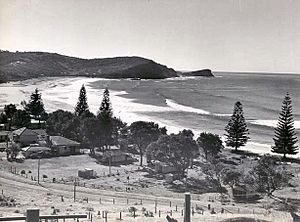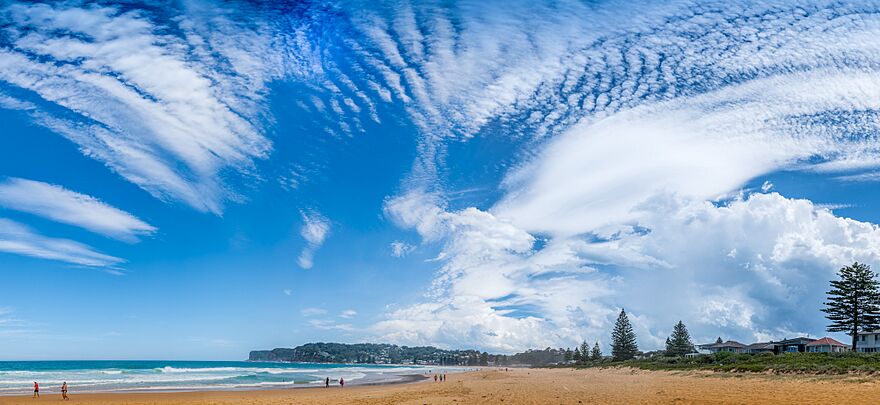Avoca Beach facts for kids
Quick facts for kids Avoca BeachCentral Coast, New South Wales |
|||||||||||||||
|---|---|---|---|---|---|---|---|---|---|---|---|---|---|---|---|

The view of Avoca Beach and the rockpool
|
|||||||||||||||
| Population | 4,584 (2016 census) | ||||||||||||||
| • Density | 1,146/km2 (2,970/sq mi) | ||||||||||||||
| Postcode(s) | 2251 | ||||||||||||||
| Elevation | 8 m (26 ft) | ||||||||||||||
| Area | 4.0 km2 (1.5 sq mi) | ||||||||||||||
| Location |
|
||||||||||||||
| LGA(s) | Central Coast Council | ||||||||||||||
| Parish | Kincumber | ||||||||||||||
| State electorate(s) | Terrigal | ||||||||||||||
| Federal Division(s) | Robertson | ||||||||||||||
|
|||||||||||||||
Avoca Beach is a beautiful coastal suburb located in the Central Coast region of New South Wales, Australia. It's about 95 kilometers north of Sydney. Avoca Beach is mostly a place where people live, but it's also a very popular spot for tourists and holidaymakers. It's especially famous for its great surfing waves and often hosts regional surf competitions.
The village of Avoca Beach has lots of cool places to visit, like restaurants and cafes. You can also find a post office, a newsagent, a pharmacy, and a mini-mart. There's even a historic cinema called the Avoca Beach Theatre, a hotel, a bowling club, a motel, and a caravan park for visitors.
Contents
Exploring Avoca Beach's Location
Avoca Beach sits right on the edge of the Tasman Sea, which is part of the Pacific Ocean. It's about 17 kilometers east-southeast of Gosford and roughly halfway between the big cities of Newcastle and Sydney. This means it's about 95 kilometers from each of those major cities.
What Borders Avoca Beach?
To the north, Avoca Beach is bordered by the Bulbararing Lagoon. To the west, you'll find Saltwater Creek, and to the east, of course, is the vast ocean!
A Look at Avoca Beach's Past
The land where Avoca Beach is today was originally home to the Darkinjung and Awabakal Aboriginal people. The name "Avoca" comes from an Irish word that means "great estuary" or "where the river meets the sea." It's also the name of a town in County Wicklow, Ireland.
Early European Settlement
On January 4, 1830, an Irish army officer named John Moore was given 640 acres of land in this area. It took a while for the official paperwork to be ready, so he didn't get the deeds until September 30, 1839. He built a house near Bulbararing Lake (which is now known as Avoca Lake). He also started growing grapes, grains, and fruit trees. John Moore left the area in 1857 to look for gold in Victoria.
Later, in the late 1800s, a man named Tom Davis leased the land. He used the local timber, which was transported by a special tram to a mill in Terrigal. The path of this old tram is now called Tramway Road in North Avoca.
Growing into a Popular Spot
In the 1950s, more businesses started to appear in Avoca Beach. These included a bakery, a service station, a butcher shop, a mini-mart, and a caravan park. The famous Avoca Beach Theatre also opened around this time.
Over the 20th century, more and more houses were built in Avoca Beach. It became a very popular place for wealthy people from Sydney's North Shore to go for holidays.
A Shipwreck Project
In 2010, there was a plan to sink an old navy ship, the HMAS Adelaide, off the coast of Avoca Beach. The idea was to create a special place for divers to explore. However, some local residents were worried about how this might affect the waves, tides, and sand movement. They were also concerned about making sure the ship was completely clean of any dangerous materials before it was sunk.
After some discussions and investigations, the plan was approved. Despite a few more attempts to delay it, the Adelaide was finally sunk on April 13, 2011, creating a new underwater attraction.
Who Lives in Avoca Beach?
According to the 2016 census, there were 4,584 people living in Avoca Beach. Most of them, about 76.4%, were born in Australia. The next largest group, 8.9%, were born in England. Almost everyone, 90.9%, spoke only English at home.
When it comes to beliefs, about 34% of people said they had no religion. The next most common beliefs were Catholic (22.5%) and Anglican (19.9%).
Interesting Facts About Residents
The average age of people in Avoca Beach was 41, which is similar to the average age for the whole Central Coast area. People in Avoca Beach generally earned more money than the regional average, with a median income of $764 per week.
In 2016, there were 1,527 homes in Avoca Beach, and most of them (83.3%) were separate houses. The average monthly payment for a home loan was $2,167, which was higher than the regional average of $1,750.
By 2020, the average price for a house in Avoca Beach was $1,150,000. This was higher than the average of $940,000 for the wider Central Coast region.
Learning in Avoca Beach
Avoca Beach has its own state primary school, which first opened its doors in 1935. For older students, the suburb is part of the area served by Kincumber High School.
Images for kids









